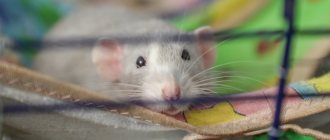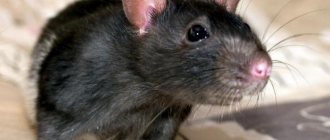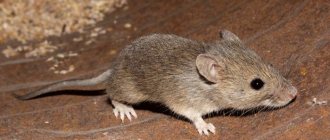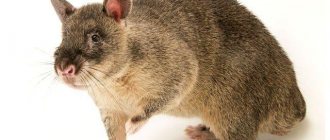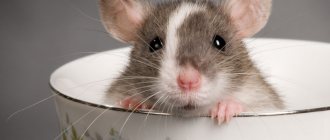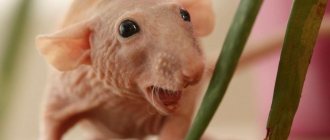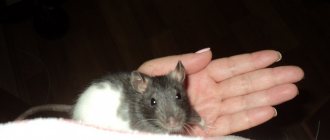Most often, rats have a dark fur color, ranging from silver to brown or black, but there is an artificially bred line of albino rats. They are happily adopted by families hoping to get a peaceful and docile pet of an unusual color. Where these rodents came from and what features they have, we will consider further.
How did white rats appear?
Albinos are descended from ordinary wild rats. In nature, snow-white individuals are extremely rare. Therefore, these rodents became widespread only at the beginning of the 20th century. Due to the strong similarity of their chromosomal makeup to humans, scientists have actively bred white rats in the laboratory to conduct research in the fields of genetics, virology and microbiology.
The snow-white color is explained by the complete absence of melanin pigment in the skin and coat.
The eyes of albino rats are not actually red, as is commonly believed, but completely transparent. Therefore, blood vessels are easily visible through the eyeballs. They are what give the eyes a red tint.
Varieties
The result of long-term selection work was the emergence of several subspecies of Dumbo rats, which differ in color and the presence of fur. Eared animals can be either shaggy or bald, and can also be black, white, gray and red. Depending on your taste preferences, you need to purchase the appropriate breed.
Rex
Representatives of the Rex breed have curly, dense hair that evenly covers the entire body, making the pet soft and plush. Newborn babies with protruding hair look comical and funny. Some individuals even have curly mustaches.
Sphinx
The Dumbo Sphynx breed is distinguished by its complete absence of hair. Small folds of skin can be seen on the soft, velvety body, which can be pink, white, blue or black. The length of the whiskers can be either large or small, and in some pets they are completely absent.
To preserve the genetic characteristics, experts do not recommend crossing the breed with other representatives of the Dumbo. To prevent aggression from rats with fur, it is necessary to place naked pets in a separate cage. This breed is chosen by people who are allergic to wool.
Siamese
Unique representatives of this subspecies have a soft cream coat color, against which the brown muzzle and paws look impressive.
Husky
At birth, Husky rats have a standard color range, against which white hairs may appear only after a few months.
Manx
Manx rats are tailless representatives of the species. This feature was caused by a gene mutation and caused negative reviews from specialists.
The absence of a tail has a negative effect on the skeleton and the life period of the animal, which does not exceed 12 months.
Blue mink
Blue mink is a unique subspecies that has gray wool with a blue tint. Amazing colors significantly increase the cost of baby rats on the market.
Features and differences of albinos
The main feature of albino rats is their rather poor health. Animals are prone to developing chronic diseases and tumors, and also have weak immunity. Therefore, it is better for representatives of this breed to live at home. In the wild they will quickly die. And not only because of various diseases - snow-white wool is an excellent bait for predators.
Albinos also have high cognitive abilities. First of all, they are prone to sympathy and empathy. There are cases where fluffies looked after weakened cage neighbors and even offered them their food.
Why do animals suddenly die?
If your pet roams freely, its life is at risk, the rodent can eat something and get poisoned, it can also get stuck somewhere or be accidentally crushed by household members. You need to watch the animal so that it does not fall from a height, fall out of a window or from a balcony.
Rats that live in a cage all the time can suddenly die from suffocation with food or water, get stuck between the bars of the cage, or suffer from some kind of genetic diseases. In any case, you need to show attention and care, this way you can avoid many dangers.
Dangers of a tame rat
Often, decorative rats die due to the fault of the owner; this can be either an accident or insufficient safety.
The most popular causes of premature death:
- Other pets - attack by a cat, dog or bird.
- Eating inedible items, poisonous plants, detergents.
- Fall from height, etc.
It is important to remember the truth: we are responsible for those we have tamed. Responsibility for the life and health of the pet falls entirely on the owner.
Description of the rat
Experienced rat breeders recommend that you first study, at least in general terms, information regarding the albino breed before going to the pet store for a new pet.
Appearance
The body parameters of albino rats are slightly smaller than those of the standard breed. The weight of an adult male is 400-500 g. While females weigh a little less - 300-400 grams. In addition to the pure white coat, the characteristic features of representatives of this breed are:
- strong build, oval body shape;
- small eyes and ears;
- long whiskers;
- elongated face, sharp nose;
- long scaly tail covered with sparse short hairs.
Among rats, partial albinos are very rare. These fluffies have white fur, but their eyes are black. A special feature of these individuals is the possibility of transmitting genes responsible for black or gray coat color.
Character and behavior
Despite their mysterious appearance, albino rats are very sociable and good-natured animals. Snow-white fluffies are absolutely not prone to aggression, they do not get into fights or altercations with their cage neighbors. Rodents also build trusting relationships with humans. It won't take much time to tame a new pet.
In addition, albino rats have high mental abilities. From the first days they get used to their nickname, are amenable to training, and feel the mood of the owner. They are also able to express their emotions. For example, they scream in alarm, signaling the approach of danger, or squeak contentedly with pleasure while in the owner’s arms.
Owner reviews
CoeEkaterina
At the end of May we got ourselves a little friend - a decorative rat. They named him Stephen. He is a white, handsome boy with a bald tail. Initially, we did not have a cage; Stephen lived in a box. So, this is the worst idea. He happily gnawed at the box, ran away and traveled around the apartment. We bought a cage. Now he loves his house more than anything.
The cage cost about 600 rubles. It has three floors. We put the filler down, where the pet can safely perform its intimate affairs. The second floor used to be empty, but now there is something like a covered hammock hanging. The third floor is now empty. There used to be a house, but after a while the little rat began to get stuck in the house. I had to remove it.
We buy any food for rodents. Special sticks that rats love to chew. In addition to special food, we also give bread, meat (not raw), and fruit. In principle, rats are not picky eaters. With us, Steve eats everything he can see. Quite a calm animal. But we have a little rat coward. He is afraid to leave his house, if you let him go for a walk, for example, on the table, he will take a walk, but he is afraid to eat in the wild.
You shouldn't leave things near the cage; we successfully chewed two T-shirts and one book. We don't leave things around anymore. Even if it seems to you that the little thing is far away and he won’t reach it, then you are wrong. Somehow, miraculously, they will get everything through the bars :)
Teaching a rat some commands is quite difficult, but quite possible. We are now trying to rid the baby of fear. As I said above, she is afraid to be outside her home. Next we will teach some basic commands.
Is it worth buying a rat? If you don't like animals, don't buy. And of course, if you are too lazy to often change the litter, wash your pet and care for it, then not only should you not buy a rat, but any other animal too.
arth
I had both hamsters and mice. But I was drawn to heavier artillery.
I went to the nearest pet store and bought an ordinary white rat (female, about 5 months old). Classic, white fur, red eyes, pink paws and a tail barely covered with fur, I had to call her Lariska.
She put her in a small cage in which a hamster had previously lived, and soon went to buy a new one, the rat had no place to turn around! A couple of weeks later, I bought her a friend (who, by the way, is her sister), at first they fought and sorted things out in a very funny way, but then they became friends and began to sleep together and play, only sometimes they took food from each other.
And a couple of weeks later, the second rat gave birth to 11 baby rats, 10 alive and 1 dead! (I knew I was buying a pregnant one). And I was amazed at how good and responsible mothers rats are! She gathered everyone in a heap under her and fed them, washed and cleaned them, built a nest for them when she felt danger, and dragged each one to a new place. Very cute. The rat babies grew up very quickly, and I had to give them away, I kept one for myself, the little rat was born of the Dumbo breed.
bird777
My love for rats began with the very first black and white rat, Felix, whom I bought at the market as a little rat. He immediately captivated me because he didn’t bite at all; before I had rats, I had hamsters, and I came across very biting ones that were even impossible to tame.
Rats will not sit on your hands for a long time, they are twisted, they always need to move and run somewhere. That's why a cage needs a wheel. But preferably something completely metal, otherwise they will chew the plastic one, as happened with us.
Food: I bought wheat, corn, barley, peas, seeds, rye at the market where they sell food for domestic chickens, mixed everything, and I got the main food for rats. In the summer she brought them green grass. Be sure to bring twigs from trees all year round; they need something to chew on to wear down their teeth.
In general, they eat everything. It goes without saying that they cannot have any “human” food, especially fried or boiled food. But sometimes we still couldn’t resist pampering them with a cookie or a piece of bread. They also sometimes gave us bones from chicken legs; the rats simply adore them and eat almost the entire bone. They also like cucumbers, various fruits, and boiled eggs.
The main disadvantage of rats is their unpleasant odor. It was heard even from one little rat, and when I had 9 of them, I had to clean the cages every day. But in principle, it’s not difficult to just change the bedding in the cage every day, especially if you have 1-2 rats and you clean it every day, there won’t be an unpleasant smell in the house. At first I used sawdust. Then I tried hay, but the smell from the hay became simply hellish, I quickly abandoned this idea.
The best option turned out to be mixing wood cat litter with sawdust, as this will reduce the smell.
You can also bathe the rats, then they will smell even less. We simply filled the bathtub with water and let them swim. It is advisable to put something in the middle that the rats can climb on to rest and swim further. Everyone swam with pleasure. Then the wet ones are very funny, but when they dry, they become even fluffier and odorless. The main thing is to place a cage with wet rats, where there is no draft, and under no circumstances bathe them if it is cold in the house.
Video
How long do albinos live?
Albino rats get sick quite often. They have a very weak immune system, so even a common cold can lead to the death of the animal. Often representatives of this breed die at the age of 1.5-2 years. While the life expectancy of rats of other varieties is 3-3.5 years.
However, owners of albinos can still extend the life of their pet. To do this, you need to take care of the furry’s health - organize proper nutrition, protect the cage from cold and drafts, and maintain cleanliness in the animal’s home.
Also, at the slightest manifestation of painful symptoms, you should immediately take the rat to the veterinarian. If the above conditions are met, you can safely extend the life of an albino to 3 years.
Why is the rat's life span so short?
How many years an animal will live depends on its genetics - the lifespan allotted by nature is written in the DNA of the rodent. The lifespan of a rat is directly related to the reproductive ability of the animal.
Rats are ready to breed from 1.5 months of age. In one litter, a female can bring up to 14 rat pups. Having not yet stopped feeding the offspring, the tailed mother is already ready for a new pregnancy. It is because of this that it is prohibited to keep rodents of different sexes in the same cage - the female will give birth continuously, and this will be an excessive burden on her body.
Another reason for the short life of a rat is its high-speed metabolism. Without food, these animals die in just 2-3 days - the rodent body, which does not receive food, eats itself.
Care and maintenance
For the normal growth and development of the animal, it will be necessary to provide it with proper care and create comfortable living conditions. This is not difficult to do, just follow a few basic recommendations:
- Organize a suitable microclimate. Due to poor health, albinos are very sensitive to environmental conditions. Therefore, it is better to place your pet in a shaded room with an air temperature of +20-22ᵒC and a humidity of 60-70%.
- Choose a cage responsibly. The structure should be spacious, preferably multi-tiered, with a secure lock. To avoid escape, the optimal distance between the rods is 10-12 mm. Inside you will need to install a house and several hammocks for relaxation, a play complex with a variety of equipment, 2 feeders and 2-3 drinking bowls. Trays can be installed if desired. Albino rats are very intelligent animals, so they can be easily trained to go to the toilet in one specific place.
- Take care to implement sanitary and hygienic measures. First of all, choose a cage with a plastic tray that can be easily removed and washed. It needs to be cleaned at least 2 times a week. Feeders and drinkers should be rinsed with boiling water every day. Once a month you will need to thoroughly disinfect the cage itself and everything inside.
- Pay attention to the hygiene of the pet itself. Albinos are very clean and lick their own fur. However, 1-2 times a month you need to give your rat a warm bath. For this, a regular basin is used. After bathing, the fur will need to be thoroughly dried with a towel so that the animal does not catch a cold.
Sick and weakened individuals require special care. They are not able to wash themselves and clean their fur coat. Therefore, it is necessary to wipe your face with it after each meal until complete recovery. And brush the fur, especially in the genital area, once a day - in the evening before bed. You will also need to prevent the growth of long claws, which the animal can use to injure itself. To trim nails, it is better to buy special tweezers at a pet store.
Relationships with people
Albinos are quite smart and cunning animals, but they are quite trainable. White rats almost always remember their nicknames, and they can also remember the nicknames of their other relatives who live in the neighborhood.
Remember! You should buy a cage with a more secure lock, as these rodents can learn to open cages with simple latches.
A simple latch on the door is not an obstacle for an albino rat
We can assume that they are very friendly animals towards people, the same cannot be said about their wild relatives. White rats are quite sociable rodents. They love affection and love to have their backs stroked. Therefore, when you decide to pet your pet, he will not mind.
Important! With regular communication with your pet, you can quickly tame it. But we must remember that these rodents have excellent memory and remember well those who hurt them.
What to feed a white rat
The health of an albino rat largely depends on a properly organized diet. For convenience, you can buy ready-made specialized mixtures at a pet store (Little One Rats, Fiory Superpremium Ratty, Rat, Vaka). Or you can provide your pet with natural food, which requires more time and expense, but is more beneficial for an albino. You will need to include the following components in your rat's daily menu:
- Greens - parsley, lettuce, celery, dill. For variety, even ordinary grass will do - wheatgrass, dandelion, plantain.
- Cereals. The basis of the diet is wheat. Additionally, it is worth offering the albino rat unpolished rice, oats, corn, millet, and buckwheat.
- Fresh vegetables and fruits - cucumber, broccoli, carrots, zucchini, apple, banana, pears, pumpkin.
- Fermented milk products - crumbly cottage cheese, fermented baked milk, kefir, low-fat yogurt, curdled milk, Varenets.
- Lean meat - boiled beef, chicken, rabbit, turkey. You can also offer boiled fish and seafood 2-3 times a week.
For weak albino rats, foods prohibited for rodents can be harmful: candy, sausages, potatoes, cheeses, smoked meats, spices, and fatty foods.
Occasionally, 1-2 times a week, you are allowed to pamper your pet with various treats - grain cookies, nuts, seeds, dried fruits, dried mealworms. Also, don't forget to drink. For normal metabolism, the fluffy dog must have unhindered access to fresh water.
French dream book
A white mouse is a sign of flirtation and fleeting infatuation. If a mouse sits on a woman’s lap, she will receive an invitation to a date with a young gentleman. If a mouse runs across the bed - the appearance of a secret and passionate admirer. If she gnaws on clothes, it means a new thing ; if she squeaks, it means an unexpected gift. If you dreamed of a white mouse with a bow or other decoration, you are in for some festive fun. If a mouse eats cheese , it is a sign of money and prosperity, big income.
Breeding Albinos
Puberty in albino rats is completed by 6-7 weeks of life. But at this age, mating is extremely undesirable, since the young, fragile body of the female will suffer greatly from bearing babies and subsequent births.
The optimal age for breeding albinos is considered to be 3-4 months. The female comes into heat once a week. It is during this period that a male should be placed in her cage. Mating games last 3-4 hours, after which the boy can be separated.
Pregnancy in albino rats lasts on average 3 weeks. After 8-12 days you can see signs of an interesting situation:
- noticeable weight gain, especially in the abdominal area;
- increased appetite;
- frequent mood changes;
- nesting - the female spends a lot of time in one corner and constantly drags paper, fabric, and filler there.
Pregnancy and childbirth in rats usually go well and do not require additional human intervention. At the appointed time, the female gives birth to pups, independently gnawing the umbilical cord and clearing the cubs of amniotic fluid. After carrying out hygiene measures, the new mother gathers all the newborns into a pile and begins feeding.
Despite the fact that a rat has only 12 nipples, and often produces many more babies, there is enough milk for everyone. Lactation is well developed in rodents. The female will simply divide the babies into 2 groups and feed them in turn.
During the first 2-3 weeks, you should not handle the baby rats, otherwise the female may abandon the cubs.
At the age of 5-6 weeks, the pups are ready to leave their mother. This is especially true for boys. To prevent a rat that has recently given birth from becoming pregnant again, it is better to remove young males early - at the age of 4-5 weeks.
Feeding
The main diet of a decorative rat consists of cereals and cereals; they also eat well succulent foods such as apples, carrots, grapes, bananas, in general, almost all fruits and vegetables.
There is a stereotype that rats are omnivores, but this is not true. It is not recommended to give rats salty, sweet, fatty, fried, carbonated foods. The rat itself will not sort out what it can and cannot do; just like a person, it is guided by the concepts of “tasty - tasteless.” Few people know, but rats love insects very much, I offered them Zophobas larvae, marbled cockroaches, Turkmen cockroaches, rats eat them as a favorite treat, regardless of whether they are hungry or not.
How much does an albino rat cost?
The cost of albino rats is quite high. To buy a snow-white rat pup from a professional breeder you will have to shell out 1000-1500 rubles. On the poultry market, the cost of an unusual pet may be slightly lower - from 500 to 700 rubles.
When purchasing, you need to pay attention to the color of the eyes - in true albinos they will only be red. In partial ones, they may be black.
Albino rats are a great option for those who prefer to have loving and loyal pets. In addition, the new owner will be delighted with the magical appearance of the fluffy, his extraordinary mental abilities and easy-going character.
Choosing a name for Dumbo the rat?
The owners are trying to give the young, smart baby Dumbo a deep and meaningful nickname in the hope that the animal's name can influence the character and intelligence of the funny animal. Sometimes it can be difficult to immediately name a pet with a suitable name that emphasizes its individuality and expresses the love of its owner.
It is advisable to take a few days to take a closer look at the habits and character traits of the new family member; most likely, he himself will tell the owner what to call him. The furry baby's nickname can be tied to the color of the rodent's coat and funny ears, human associations from the pet's appearance and funny faces, favorite book and cartoon characters or pop stars. The rodent's nickname should be simple and easy to pronounce in a diminutive form. It is believed that females respond better to nicknames that begin with the letters K, M and D. Males are more fond of names with the letters S, K, M and D, long-eared pets are more willing to get used to nicknames with the letters T, N, L, M, K , S, Sh and R.
The name for a Dumbo rat girl can be: Knopa, Scully, Masya, Dana, Molly, Ksyusha, Marta, Alice, Dasha, Klava, Matilda, Gina, Darcy, Alpha, Kayla, Linda.
The name for a dumbo boy rat can be: Kuzya, Tyson, Tim, Rocky, Simson, Garik, Steve, Venya, Bucks, Rocky, Dick.
It doesn’t matter what the owner calls the smart-eared baby. In any case, the baby rat Dumbo will sincerely adore and faithfully wait for his beloved owner, giving him his incredible tenderness and selfless love.
Video
Genetics
The lifespan of a house mouse is influenced not only by lifestyle, but also by genetic predisposition.
The fact is that in pet stores, rats live in mixed-sex packs, which does not happen in the wild. Animals living in crowds mate uncontrollably, after which they live in cramped conditions unsuitable for normal existence. It is very difficult to trace the genetics of such an animal, so it is impossible to say how long such a rat will live and what life awaits it.
A completely different situation arises when animals are bred by a breeder. Matings in such cases are planned, and partners are selected depending on temperament. Rat pups from peaceful, sociable parents are prepared for sale as pets. Such babies are brought up in a favorable environment, which prevents the pet from displaying aggression in the future.
Females in nurseries give birth to cubs no more than twice a year. Frequent pregnancies exhaust the animal, as a result of which it produces weak, non-viable litters.
In order for a pet to be healthy, please its owners and live a long life, it must be purchased only in special institutions.
You will learn how to make the life of a pet rat comfortable in this video.
Yellow-necked mouse
These mice became a separate species back in 1894, and in 2008 they were listed in the Red Book of the Moscow Region. Their main difference is the bright red color of the skin. They have a yellow stripe around their neck. The ears of yellow-necked mice are large, round, and the body length reaches 10 cm.
We invite you to familiarize yourself with Red Neon (Paracheirodon axelrodi)Aquarium in detail
These animals live in the southern part of Russia, but are also found in the north. They are dangerous because they carry various diseases (the most dangerous is tick-borne encephalitis). These mice live in forests, occupy hollows and nests, and sometimes dig holes in the roots of trees. He prefers seeds from food (acorns, beech, hazelnuts, etc.).
Historical reference
Not only the Japanese have achieved success in taming vicious and dangerous rodents. In the 18th century, Europe was shaken by an invasion of gray rats. Millions of these animals came from Asia. The gray hordes crossed rivers, forests, mountains and terrified the inhabitants of the countryside. In Europe at that time, only the black rat existed, but the larger and more aggressive pasyuki quickly took a dominant position. They became the scourge of cities and villages.
People, naturally, killed and poisoned the animals in every possible way. In addition, they began to organize mass entertainment, where shepherds were driven into a special fenced area and trained dogs were brought. They strangled rodents in front of the public. The dog that strangled 100 rats in the shortest time became the winner. It is believed that the most successful was a terrier named Bill. He strangled 100 long-tailed animals in 5 and a half minutes.
Gray animals were caught and killed, but sometimes albinos were found among them. Some enthusiasts preserved them as outlandish specimens. They multiplied, and offspring with a wide variety of colors were born. This is the second way, besides Japan, that white rats appeared. At the end of the 19th century, such animals began to be popular with rich ladies. They were kept at home in squirrel cages.
At the beginning of the 20th century, the first laboratories appeared, in which they also began to breed and crossbreed unpleasant, toothy rodents. But these animals were mainly used for scientific research. When such a concept as genetics came into science, animals became simply irreplaceable. In 2003, two laboratory rats were cloned. Currently, a wide variety of experiments are being carried out on thousands of ornamental animals related to medicine, genetics, virology and other branches of science.
